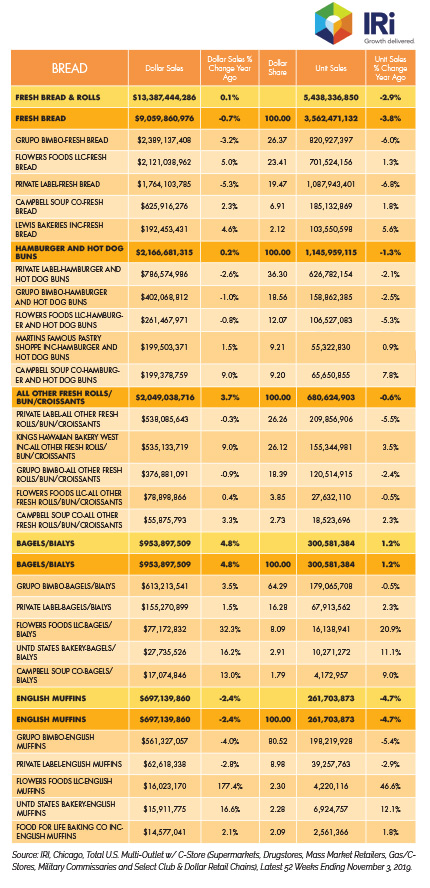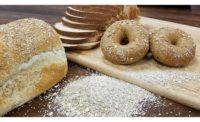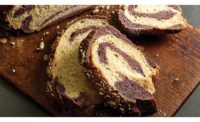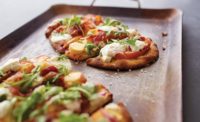Despite pockets of growth at individual companies, the categories spanning fresh bread—including bread, buns and rolls, bagels and English muffins—continue to remain relatively flat. But bakers have some strategic tools at their disposal to help drive incremental growth and attract shopper attention.
Foodservice perspectives
“Sandwich trends will continue to be driven by global flavors in 2020, with continued growth of options like bánh mì and Cuban sandwiches on menus,” says Mike Kostyo, trendologist, Datassential, Chicago. “French, open-faced sandwiches have been a real area of opportunity, and we expect tartine and croque madame sandwiches to continue growing on menus in the year ahead. Bao buns and naan have also seen growth in applications beyond the cuisines they are associated with. We’ve seen peanut butter and jelly bao and garlic naan breakfast sandwiches on menus, to name just two examples. We’ve seen a few chains trying out katsu sandos, so we expect to see those grow in 2020.”
Operators are looking for new and unexpected bread and bun alternatives, says Bill Hanes, vice president, marketing and strategy, Lesaffre, Milwaukee, WI. Foodservice operators are now expanding to alternatives like naan, dosas, and roti.
Kostyo notes that two of the biggest sandwich trends of 2019—the growth of plant-based items and the fried chicken sandwich wars—will evolve in the year ahead. While burger formats have driven the plant-based trend so far, more plant-based products, like deli meats, chicken, fish, and cheeses, are in the pipeline and will impact sandwich carrier choices.
“I expect we’ll see more focus on incorporating plant-based proteins into the sandwich carrier, as well,” says Matt Gennrich, senior food technologist, R&D bakery applications, Cargill, Minneapolis. “Soy flour, pea protein, wheat gluten and other plant proteins can all add a protein boost and reinforce the plant protein story showcased in the sandwich filling.”
Alignment with vegan is also a potential plus. “Buns and rolls featuring innovative flavor profiles and clean-label ingredients that support increasingly popular diets, such as vegan diets, should see sizable growth in 2020 and beyond,” says Cam Suarez-Bitar, marketing and public relations manager, Bellarise, Pasadena, CA.
Some concern over whether these options are really healthier has arisen, so some operators may seek out carriers that can add a health halo to a product, notes Kostyo. Two healthy options to consider when it comes to carriers are chia and hemp, which can be used in seed breads, as a crunchy topper, or ground and used as a flour. “We’ve seen both options grow triple digits in just the past year alone and expect their growth to continue in 2020.”
Datassential notes that lobster rolls continue to grow on menus, and are predicted grow another 17 percent in the next four years. “As they grow, offering other carrier options or calling out the use of an authentic split-top bun can set an operator apart,” says Kostyo.
Also, Hawaiian bread or buns still have plenty of room for opportunity in the year ahead—options that score very well with consumers, but are still on less than 1 percent of menus, notes Datassential.
Retail formulations
Pam Stauffer, global marketing programs manager, Cargill, Minneapolis, notes recent research has shown shoppers are attracted to “fresh” products that have a “less processed” perception. “Consumers continue to be attracted to products they perceive as minimally processed, made with simple, recognizable ingredients.” These ideals are highly achievable in bread products.
“Clean label, non-GMO, and organic will continue to lead the way forward as consumers seek out healthier and more authentic breads,” says Suarez-Bitar. “Sugar reduction has also been top of mind for North American bakeries and consumers, as well as holistic health, vegan diets, artisan-style breads, and portion control.”
Formulating organic and conventional bread using wholesome ingredients is “the new normal,” suggests Suarez-Bitar. “A rising expectation among U.S. consumers is for breads to have cleaner and shorter labels, while always promising a good value and a fulfilling eating experience.” Bakeries have taken note and are adopting new processes, while working with ingredient manufacturers on innovative extended-shelf-life (ESL) solutions as the bread aisle gains inspiration from American and international artisan styles, he notes.
By embracing the ideas of “freshness” and “clean label,” bakers can provide consumers with more buying choices that fit their needs, suggests Harold Ward, director of technical services, Bay State Milling Co., Quincy, MA. “Keep in mind, as interest in these areas continues to grow, clean label in particular poses the challenge to product developers and formulators of doing more with less.” This opens the door to multifunctional ingredients, such as Bay State Milling’s HealthSense high fiber wheat flour and SowNaked Oats, which provide bakers with tools to address fiber and protein needs in their products.
“Today’s consumers expect a lot from the breads they purchase at retail, including a clean label and no artificial flavors or preservatives,” says Mohammad Emami, senior product manager, Bartek Ingredients, Stoney Creek, Ontario. “Consumers also expect their bread to stay fresh in their pantries and kitchens without quickly molding or becoming stale. And, of course, they expect their bread to taste great.”
Emami notes that recent work toward enhancing the functionality of fumaric acid can help bakers meet these expectations, including for artisan-style products. “Our artisan bread technology improves the manufacturing efficiency, cost-in-use, and overall quality for artisan breads produced at an industrial scale.”
Bartek has also introduced new ingredient systems to reduce calcium propionate and improve the quality of pan breads. “Our proprietary technology offers not only improved product attributes, including increased volume and softer texture, but it also reduces the use level of calcium propionate, lowering cost in use without compromising the product shelf life. It does this using only clean-label ingredients,” says Emami—and without adding cost.
One trend of note is smaller, sometimes half-sized loaves that support reducing food waste, notes Nicole Rees, product director, AB Mauri North America, St. Louis. This movement to reduce food waste fits well with ESL products. “Certainly, freshly baked bread has its benefits, but shelf life and preservation are not two of them. Just compare in-store bread to packaged loaves, which feature dough conditioners, softeners and mold inhibitors—often clean-label versions—to extend both the enjoyment and consumption of the product.”
The allure of health benefits can drive consumption of breads made with ancient grains, pulses, and superfood seeds such as chia, hemp, and flax, notes Rees. These bread products see better demand when billed as “intrinsically healthy” versus “fortified,” she says. “Consumers today are eager to try great-looking breads that also offer real benefits, such as complete proteins made from high-fiber pulses and grains.”
Sourdough is also attracting attention. “We’ve even seen a revival in sourdough artisan breads due to an increased interest around fermentation,” says Ashley Robertson, market manager, bakery, Corbion, Lenexa, KS—and this discussion can include organic acids like lactic acid and vinegar as natural preservatives. For example, Corbion’s Verdad MP 100 solution, a combination of vinegar and natural flavors, helps bakers with clean-label mold inhibition.
Fermentation also helps provide a clean label without the need for artificial preservatives, says Hanes, another boon for sourdough. Lesaffre’s Livendo sours can help bakers take advantage of this growing market, he notes. Also, Lesaffre’s Delavau Bakery Partners by Saf-Pro group offers Encore Soft clean-label antimicrobial functionality for ESL breads while maintaining a desirable eating experience, he says.
Matt Gennrich, senior food technologist, R&D bakery applications, Cargill, notes that emulsifiers like DATEM and mono- and diglycerides are often are tagged for replacement. “We’ve had good success replacing these ingredients with canola or sunflower lecithin in bread formulations.”
More alternative flours are finding their way into bread products. “Consumers looking to increase their consumption of plant-based protein are turning to these new creations to fill in nutrient gaps in their diet,” says Robertson. “Alternative flours like chickpea, soybean and pea are also great for consumers with dietary restrictions like gluten sensitivity, as they’re all gluten-free.”
Almond flour is another option for gluten-free—and Paleo or keto diets, suggests Jeff Smith, director of marketing, Blue Diamond Almonds Global Ingredients Division, Sacramento, CA. He says almond flour offers important nutrients like calcium, fiber, iron and protein that may be missing in many gluten-free products—and adding Blue Diamond Almond Protein Powder can add an additional protein boost.
Process improvements
The demand for healthy bread products with higher protein or fiber, as well as gluten-free options, can challenge bakers when it comes to handling the dough, says Richard Breeswine, president and CEO, Koenig Bakery Systems, Ashland, VA.
Dough for artisan breads should be treated with particularly gentle care, says Breeswine. “Take the time and analyze every process step. A particularly critical point is the timing between the mixer and production line operator when producing doughs with longer fermentation time.”
Sprouted grains, seeds and other additions to dough can change its consistency, impacting certain processing stages, says Breeswine. He suggests bakers soak the seeds and sprouted grains in water for several hours before mixing, allowing the seeds to absorb the water before flour has been added. “This prevents the dough from becoming very firm after mixing during resting time.”
Koenig also advises bakers to add the sprouted grains and seeds only at the end of mixing, says Breeswine. “This ensures a good dough texture and avoids a sticky, greasy consistency.”








